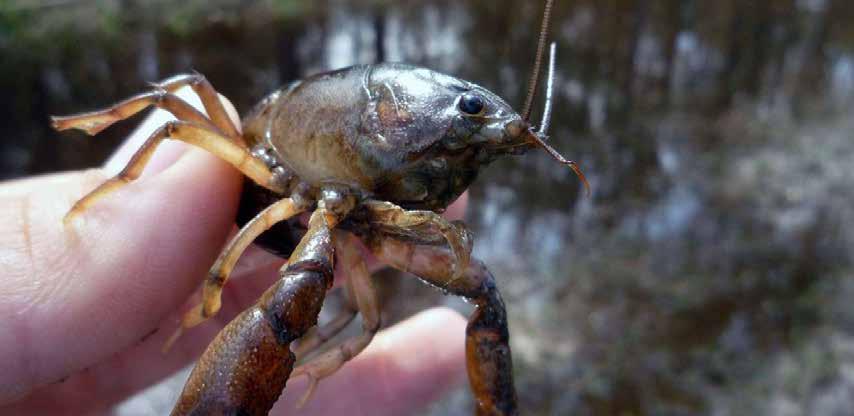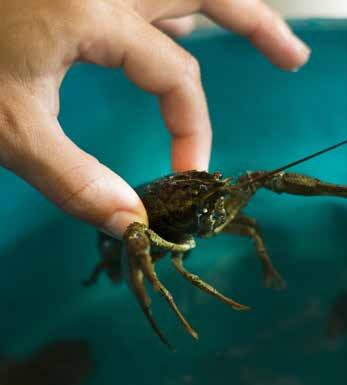
5 minute read
POLITICAL PERSPECTIVE
Panama City Crayfish Are Here To Stay
by: Melissa Lupton, VP of Governmental/Military Affairs
You just thought you had heard the last of this 2-inchlong crustacean, but these little guys aren’t quite done stirring the pot in Bay County and no, we’re not talking gumbo. Many can remember the Panama City Crayfish (PCC) issue surfacing throughout the years, but the battle continues. For three years, the Chamber has held a position opposing the listing of the PCC as threatened on the endangered species list. Let’s dive into where we started, where we are today, and what could possibly come.
State Status
Rediscovered in 1986, the Panama City crayfish was thought to be extinct. A year later, conservation efforts resulted in it becoming a state listed Species of Special Concern (SSC). This listing brought some protections, created public awareness campaigns, and generated guidelines to help conserve the species and its habitat. The Florida Fish and Wildlife Commission issues permits at this level on the basis the action will not be detrimental to the survival potential of the species.
However, in 2006, a biological status review recommended a reclassification for the PCC. Attempts were made to list the species as Threatened due to its limited geographic distribution and continuing decline. This listing action sat idle for several years as officials worked to revise the listing process. Completed in 2010, the newly revised listing process phased out the SSC status and proposed to up list all species to a Threatened status if they met the criteria. Draft management plans were developed for this species in 2016, but have yet to be finalized. Once management practices are approved, the listing status of Threatened, along with new regulations and permitting requirements, will be in full force and effect.
The PCC was not on the federal worklist until 2010 when the Center for Biological Diversity petitioned the U.S. Fish and Wildlife Service to list 404 aquatic, riparian, and wetland species in the Southeastern region under the Endangered Species Act. The PCC was one of the species petitioned and studies ensued. The Center for Biological Diversity again filed a complaint in 2015 stating the Service had not completed a 12-month finding in the timeframe required by law.
The Service entered into a court-approved settlement agreement stating the 12-month finding would be completed and submitted by September 2017, later extended to December 2017. As part of this process, comments were accepted to the Federal Register from January to March 2018. According to U.S. Fish and Wildlife, final determinations are largely driven by the number and types of comments the agency receives during the public comment period. Consideration given to comments based on biological or commercial data. A final listing status was anticipated before the end of 2018. At the time of the January 3, 2018 proposal, critical habitat was not determinable because the Service had not completed the necessary analysis. With the critical habitat analysis and draft economics analysis complete, the Service reopened the proposed listing for public comment, along with a proposed 4(d) rule and critical habitat designation from April 2021 to June 2021.
Impacts/Identified Threats
Federal protections would restrict and result in expenses associated with mitigating loss of habitat. These additional costs are generally passed on to taxpayers on all levels of government-funded projects, resulting in lessened services or additional taxes as mitigation expenses drive up the cost of project plans.
There are several approved infrastructure developments and roadway expansions (widening of Star Avenue, Kern Avenue, Tram Road) that are planned for construction. These are expected to affect several crayfish sites. The type of impact and the amount of land involved will determine whether on-site or off-site mitigation or payment into the PC Crayfish Conservation Fund would apply.
Activities that result in the loss of population include development, silviculture (timber cultivation), bait, off-road vehicle use, and drought. Infrastructure improvements remove specific soil and vegetation requirements; and can isolate populations. Off-road vehicles may rut and crush. Silviculture practices can affect PCC habitat through ditching, bedding, and roller chopping. Several crayfish sites are utilized by fishermen for harvesting bait.
Species Conservation
Currently, voluntary draft guidelines developed by the FWC can help guide development projects that may impact the PCC and its habitat, but these are not regulatory in nature. If the PCC were to be federally listed, the U.S. Fish and Wildlife Service would be required to work to protect and recover it. Recovery means that the PCC would no longer need protection.
About 230 acres are in protection, however the U.S. Fish and Wildlife states that the PCC needs 2,200 acres in specific areas, managed in perpetuity, for conservation. According to a cost assessment analysis prepared by the Center for Economic Forecasting and Analyses at Florida State University in 2018, the cost for this acreage would be approximately $20 million. This does not include recurring costs to manage the lands.
The state has allocated $4 million to assist in purchasing the necessary land for conservation, however appraisals of said acreage are still underway.
The Service has proposed a 4(d) rule which focuses on specific conservation efforts such as prohibiting the following activities, except as otherwise authorized or permitted: importing or exporting; take possession and other acts with unlawfully taken specimens; delivering, receiving, transporting, or shipping in interstate or foreign commerce in the course of commercial activity; or selling or offering for sale in interstate or foreign commerce.
The proposed 4(d) rule would also provide for the conservation of the species by allowing exceptions to actions and activities that may have minimal disturbance to the Panama City Crayfish and are not expected to impact the species conservation and recovery efforts negatively. The proposed exceptions to these prohibitions include conservation efforts by the Service or state wildlife agencies, certain development practices, select land management activities, and some utility actions expected to have negligible impacts on the Panama City crayfish and its habitat.
The Chamber continues to monitor any action regarding the species’ listing, and will continue our efforts to ensure it does not interrupt business in Bay County.
For additional information regarding the listing, status visit the Federal eRulemaking Portal at http://www.regulations.gov. Docket number FWS-R4-ES-2017-0061.








